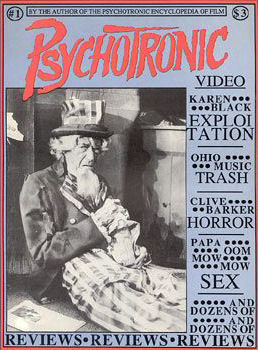- Psychotronic Video
Infobox_Magazine
title = Psychotronic Video
 | image_size = 200px | image_caption =Cover of Issue #1
| image_size = 200px | image_caption =Cover of Issue #1
editor =Michael J. Weldon
frequency = Quarterly
category =Film
company =
firstdate = 1989
country =United States
language = English
website = http://www.psychotronicvideo.com/
issn ="Psychotronic Video" was a film magazine originally started by
publisher /editorMichael J. Weldon in1980 inNew York City as a hand-written and photocopied weeklyfanzine entitled "Psychotronic TV". It was then relaunched by Weldon under its more commonly known name as an offset quarterly in1989 . Both versions of the magazine covered what Weldon dubbed "Psychotronic Movies", which he defined as "the ones traditionally ignored or ridiculed by mainstream critics at the time of their release: horror, exploitation, action, science fiction, and movies that used to play in drive-ins or inner city grindhouses." Weldon, Michael J. "Psychotronic Video" Magazine, issue #1 (1989), pg. 2. Editorial entitled "Welcome to the First Issue of Psychotronic Video!"] Weldon coined the term after being inspired by "The Psychotronic Man " (1975), alow budget science fiction obscurity. [cite web|url= http://www.psychotronicman.com/ |title="The Psychotronic Man"|accessdate=2007-11-07|first=|last=|publisher=Psychotronic Man website]Most of the magazine's hundreds of reviews were written by Weldon himself. In each issue, other contributors provided career histories/interviews with cult directors and actors such as
Radley Metzger ,Larry Cohen ,Jack Hill ,William Rotsler ,David Carradine ,Sid Haig ,Karen Black , andTimothy Carey . Regular features included "Record Reviews" by Art Black, "Spare Parts" (fanzines and comics) by Dale Ashmun, and "Never To Be Forgotten", an extensiveobituary column by Weldon that covered the deaths of writers, directors, television and film actors, rock stars, comic book artists, lawyers, and anybody else Weldon felt was related to the overall Psychotronic-universe.In December of
2006 , Weldon announced that he was ceasing publication of "Psychotronic Video" after 18 years and 41 issues. [ [http://community.tvguide.com/thread.jspa?threadID=700004011 "Sad News: "Psychotronic Video" Magazine Gives Up the Ghost"] , column byMaitland McDonagh , "TVGuide.com", July 17, 2006. Retrieved 11/07/2007.] Citing increasingly expensive printing costs and dubious business practices from distributors as his main source of concern, he noted that "It was a struggle to self-publish in the 80s and 90s but now it’s nearly impossible." [ [http://www.psychotronicvideo.com/wow/vestibule.shtml Announcement from Michael Weldon] , "psychotronicvideo.com". Retrieved 11/07/2007.]Psychotronic books
Prior to the appearance of the second version of the magazine,
Ballantine Books published "The Psychotronic Encyclopedia of Film" (1983), a 813-page compilation of mini-reviews of over 3,000 cult films. The book was written by Weldon with editorial assistance from Charles Beesley, "Fangoria"'s Bob Martin, and Akira Fitton. TheForeword byChristopher Cerf credited the success of the original fanzine as direct inspiration for the publication of the book. In 1996, asequel was published bySt. Martin's Press , "The Psychotronic Video Guide", credited solely to Weldon.References
External links
* [http://www.psychotronicvideo.com/wow/vestibule.shtml Michael Weldon's Psychotronic Web]
Wikimedia Foundation. 2010.
